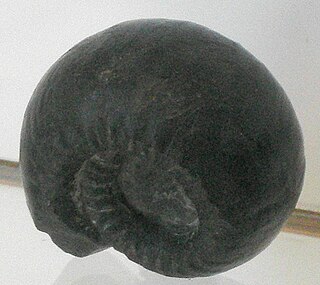
The Nautilida constitute a large and diverse order of generally coiled nautiloid cephalopods that began in the mid Paleozoic and continues to the present with a single family, the Nautilidae which includes two genera, Nautilus and Allonautilus, with six species. All told, between 22 and 34 families and 165 to 184 genera have been recognised, making this the largest order of the subclass Nautiloidea.

Goniatids, informally goniatites, are ammonoid cephalopods that form the order Goniatitida, derived from the more primitive Agoniatitida during the Middle Devonian some 390 million years ago. Goniatites (goniatitids) survived the Late Devonian extinction to flourish during the Carboniferous and Permian only to become extinct at the end of the Permian some 139 million years later.
Beyrichoceras is a genus belonging to the goniatitid family Muensteroceratidae, a group of ammonoids, extinct shelled cephalopods related to belemnites and recent coleoids and more distantly to the nautiloids

Ceratitida is an order that contains almost all ammonoid cephalopod genera from the Triassic as well as ancestral forms from the Upper Permian, the exception being the phylloceratids which gave rise to the great diversity of post-Triassic ammonites.
Dimeroceratidae is one of three families in the Dimeroceratoidea, a goniatid superfamily included in the Ammonoidea; extinct shelled cephalopods with adorally convex septa and usually narrow ventro-marginal siphuncles.
Prolobitidae is a family of middle and upper Devonian ammonoid cephalopods currently included in the goniatitid suborder Tornoceratina and superfamily Dimeroceratoidea, but previously included in the ancestral Anarcestida.
Cheiloceratidae is a family of ammonoid cephalopods included in the goniatitid suborder Tornoceratina in which the suture has 4 to 12 lobes, the ventral one undivided and those in the lateral areas originating as subdivisions of internal and external lateral saddles.
The Posttornoceratidae are Late Devonian goniatites (Ammonoidea) included in the superfamily Tornoceratoidea. The family, Posttornoceratidae, named by Bogoslovsky in 1962, is based on the genus Posttornoceras, named by Wedekind in 1910, originally included in the Tornoceratidae.

Gastrioceratoidea is one of 17 superfamilies in the suborder Goniatitina, ammonoid cephalopods from the Late Paleozoic.
Adrianitidae is a family in the Adrianitaceae, a superfamily of ammonites in the cephalopod order, Goniatitida, known from the Middle Pennsylvanian to the Middle Permian.
Adrianitinae is a subfamily of the Adrianitidae which is part of the goniatitid superfamily Adrianitaceae. The Adrianitinae which comprise the more advanced genera in the Adrianitidae have sutures that form 14 to 30 lobes. Shells may be discoidal or globular or in between.

Cyclolobidae: Goniatitid Ammonoidea belonging to the Cycloloboidea with thickly discoidal to subglobular shells with a small but open umbilicus and ammonitic sutures with numerous lobes that have subparallel sides.
Agathiceratidae, as revised, makes up the goniatitid superfamily Agathiceratoidea. Agathiceratidae, which lived from the Upper Carboniferous (Pennsylvanian) to the Middle Permian, combine related genera with subdiscoidal to globular shells that have a small umbilicus and goniatitic sutures and are prominently longitudinally lirate. The explanation for the Agathiceratidae is that for the Agathiceratoidea.

Medlicottiidae is a family of ammonoid cephalopods belonging to the Prolecanitida, known from the Upper Carboniferous (Pennsylvanian) to the Early Triassic.

Prolecanitida is an order of extinct ammonoid cephalopods, the major Late Paleozoic group of ammonoids alongside the order Goniatitida. Prolecanitids had narrow shells, discoidal (disc-shaped) to thinly lenticular (lens-shaped). They retained a retrochoanitic siphuncle, a simple form with septal necks extending backwards. As is typical for ammonoids, the siphuncle sits along the ventral margin of the shell.

Prolecanitoidea is a taxonomic superfamily of ammonoids in the order Prolecanitida. Prolecanitoidea is one of two superfamilies in the order, along with the younger and more complex Medlicottioidea. The Prolecanitoidea were a low-diversity and morphologically conservative group. They lived from the Lower Carboniferous up to the Middle Permian. Their shells are generally smooth and discoidal, with a rounded lower edge, a moderate to large umbilicus, and goniatitic to ceratitic sutures. Suture complexity varies from 10 up to 22 total lobes ; new lobes are added from subdivision of saddles adjacent to the original main umbilical lobe.
Ceratitoidea, formerly Ceratitaceae, is an ammonite superfamily in order Ceratitida characterized in general by highly ornamented or tuberculate shells with ceratitic sutures that may become goniatitic or ammonitic in some offshoots.
Karagandoceratoidea is an Early Carboniferous (Mississippian) superfamily within the ammonoid order, Goniatitida, said to contain the Karagandoceratidae and Prodromitidae.
Pachylyroceras is a large, generally subglobular, Upper Mississippian gonitite and included in the cephalopod subclass Ammonoidea.
The Uddenitinae a subfamily of the Medlicottiidae, a family of ammonoid cephalopods included in the Prolecanitida. The Uddenitinae, proposed by Miller and Furnish, and known from the Pennsylvanian and Lower Permian, are transitional between the ancestral Pronoritidae and the more traditional medlicottiids








